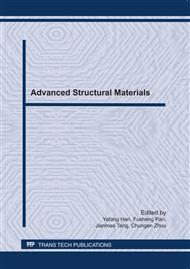p.146
p.151
p.157
p.162
p.168
p.176
p.181
p.186
p.192
High Temperature Deformation Behaviour and Processing Maps of AZ81 Magnesium Alloy
Abstract:
The hot compression deformation behavior of AZ81 magnesium alloy was studied with Gleeble-1500 thermal simulation machine at the strain rate of 0.003 ~ 3.0s-1 and temperature of 340 ~ 430 °C. The results show that, the flow stress decreases when the deformation temperature increases and strain rate decreases; the peak stress increases with decrease of the temperature and the increase of the strain rate; the critical strain that comes into stable phase increases obviously. It is that the high temperature flow stress model of AZ81 magnesium alloy is constructed by introduceing Zener-Hollomon parameters, its average deformation activation energy is 169.48 kJ / mol. Processing maps of AZ81 magnesium alloy is also calculated and analyzed by the dynamic model of the material. Useing hot deformation processing maps, the flow instability zone is determined and the best process parameters access to the test parameters during hot deformation are as follow: thermal processing temperature range of 380 °C ~ 420 °C, strain rate range of 0.01 ~ 0.03 S-1.
Info:
Periodical:
Pages:
168-175
Citation:
Online since:
June 2011
Authors:
Price:
Сopyright:
© 2011 Trans Tech Publications Ltd. All Rights Reserved
Share:
Citation:


